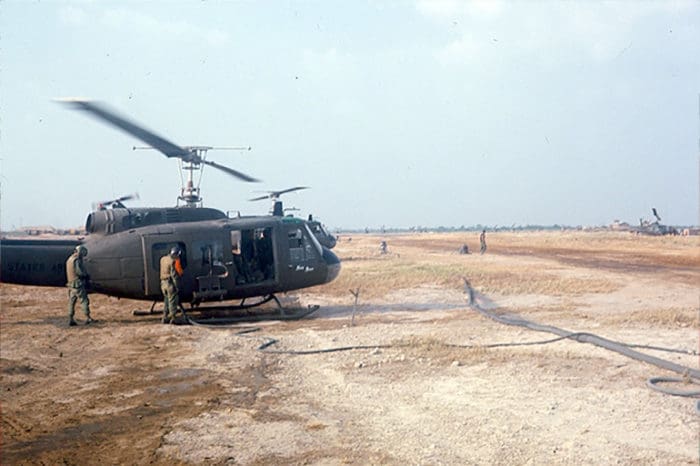By James “Bud” Harton
Years ago, eons actually, I was a crew chief/door gunner on a UH-1D Iroquois helicopter in Vietnam. I was assigned to an assault company and our unit was comprised of 24 UH-1D “slicks” as troop carriers and eight UH-1C gunships in our armed platoon.
The “slicks” earned their nickname as they didn’t have any outboard weapons, just the M60D machine guns mounted on each side of the rear of the cargo hold. Slicks carried the troops into landing zones and then kept them supplied while in the field.
The gunships, armed with mini-guns, rockets and 40mm grenade launchers, escorted the slicks in and then provided overhead cover for the grunts in the field.
Army aviation helicopter units in Vietnam in the early years of Vietnam were the cutting edge of war technology at the time and were ongoing experiments in what worked and what didn’t. Every single piece of equipment and gear, tactics and crew coordination, and standardization were all being developed while we fought the war.
We were allowed great flexibility in how we equipped ourselves. Right from the start, it was learned that the personal weapons assigned to flight crews were lacking and the possibility of “going down” meant you had to be ready to leave the aircraft and fight on your own until rescued.
Originally, we were limited to our assigned weapons, those permitted under the unit’s table of organization and equipment (TO&E). For the pilots, that meant a Smith & Wesson Military & Police Model 10 revolver in .38 special and M14 rifles for the two crew members or “GIBs” (guys in the back).
As time went on, a couple of valuable lessons were learned. The first being that when you hit the ground hard, the only thing you were coming out of the aircraft with had better have been strapped to you. That meant most of us developed a “bailout bag,” often an empty Claymore mine bag containing some basic equipment such as first aid supplies, pen flares, some “C” rations, cans of food, and ammo.
Because our M14s were in the way, back there in the transmission well where our M60s were mounted, they were slung over the pilots’ seats. It was agreed the pilots would be using those because the crew members could use their M60D machine gun once they were on the ground.
In real life, though, that almost never happened because leaving the aircraft quickly was all too often the number one priority and trying to remove an M60 from its pedestal mount or getting an M14 unslung from the back of a seat was difficult to do when the aircraft was burning or the rice-propelled people were coming for you.
So we improvised and without too much command interference, we all started developing our own selection of weapons.
After experiencing war for almost 40 years, Vietnam was rife with weapons from all over the world. Getting an AK was easy enough to do, but if you were really ultra-cool, you traded for a Swedish K or even a Thompson M1A1.
Specialist Gary Wetzel, a door gunner in our 1st platoon had a Thompson the night his aircraft was blown up by an RPG in a landing zone and he earned the Medal of Honor.
M2 carbines with both standard and paratrooper stocks became all the rage as did shotguns sent from home and specially modified with a hacksaw. A good friend of mine brought back an S&W Outdoorsman, a .38 special on a .44 frame, and I found a German made Browning Hi-Power to carry in an M3 tanker’s shoulder holster.
The Hi-Power, probably brought back from World War II as a captured weapon, had been chromed, but you could still see the German Army proof marks on the frame and barrel. The FN plant in Belgium had been overrun in 1940 by the Wehrmacht and the plant continued making weapons, but under German control.
The Hi-Power became the Pistole 640(b). How it got to Vietnam I haven’t a clue, but it became all mine for the 32 months I stayed in country and it flew on well over 1,000 sorties while I was a crew chief on a “slick” and for the greater part of my tours on a gunship.
In September, 1968, I was told I could not extend my tour any longer and I would be going home almost immediately. I didn’t have time to go to the local Provost Marshal to get an export license so I passed my beloved Hi-Power off to another crew chief and left for home.
Over the years, I very much regretted leaving it behind. But this past January, that other crew chief, Dale Hensley of South Carolina found me and asked if I wanted my Hi-Power back.
I can’t begin to describe the flood of emotion that I felt when it arrived at my local FFL. Sounds, smells and even the chatter on the aircraft intercom and radios came flooding back.
It’s pretty rough. The cheap ‘bumper’ chrome is thin and pitted, but otherwise it’s just fine. I contacted Dave Williams of the Springfield Armory Custom Shop and he agreed to strip the chrome for me and restore the original finish as much as possible.
The barrel was too badly pitted to fire so I have put it away and replaced it with another. I have changed the grips out and saved the originals because I don’t want them to suffer any more hard use.
It won’t be my everyday carry, but now I have what I consider to be the ultimate BBQ gun. It comes with its own story of war and service on three continents. How cool is that?
[This article was originally published here in 2014.]
